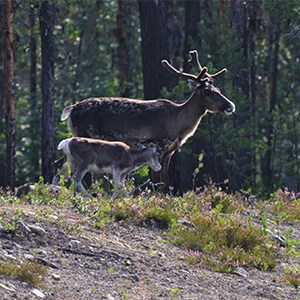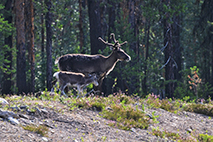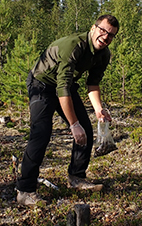Military exercises prevent reindeer from escaping insect harassment

During intense insect harassment, reindeer usually escape insects by moving faster or by choosing wind-exposed, insect-free areas. However, a recent study finds that during military exercises performed either using low-flying fighter aircrafts or ground vehicles, reindeer reaction to the exercises is to move less, which prevents reindeer from successfully escaping insect attacks.
Nowadays, even the most remote areas around the world are affected by human activities. In the apparent remoteness of northern Scandinavia, interests for natural resources and low-populated areas attract a variety of land users, such as companies within mining, renewable energy and forest industry, and some of these activities are of concern to the local communities. A study led by researchers at the Swedish University of Agricultural Sciences found that military exercises performed in the biggest European military test range, located in northern Sweden, changed the behavior of semi-domesticated reindeer, which are essential to the livelihood of the indigenous Sami people.
During summer, reindeer are commonly harassed by a variety of insects, which use reindeer as their hosts to reproduce or to feed on their blood. Reindeer usually seek refuge in windy and cool areas, or run even for hours in search for relief. This escape behavior translates in less time devoted to feeding and causes considerable stress to the animals, but lowers the negative consequences of being harassed by the insects.
The new study, run in collaboration with an Italian research team, demonstrates the consequences of carrying out a human activity, i.e. military training, during periods of intense insect harassment. The study was conducted in the spring and summer ranges of the Udtja reindeer herding community, which roughly overlap FMV Vidsel Test Range, a 1650 square kilometer area used to test different types of military vehicles and missiles.
During summer, reindeer respond to military aircraft exercises by moving less, and when this activity occurs simultaneously with mosquito harassment, reindeer end up being unable to run away from the harassing insects.
On the contrary, reindeer are generally not disturbed when the military exercises are performed with ground vehicles. However, reindeer lessen their response to mosquito harassment during ground vehicle exercises. Again, the military exercises seem to prevent reindeer from successfully escaping insects.
"Special measures should be taken into account when planning new activities in the reindeer husbandry area of northern Scandinavia; especially since insect harassment is expected to increase due to climate change, and because of the continuous expansion of human activities into the reindeer range, which generate cumulative impacts on reindeer husbandry" says Dr. Uboni, researcher at the Swedish University of Agricultural Sciences and leader of the study.
More information
Contact information (English):
Alessia Uboni, Postdoctor
Department of Animal Nutrition and Management; Reindeer Husbandry
Swedish University of Agricultural Sciences, Uppsala, Sweden
auboni@mtu.edu
Contact information (English and Swedish):
Anna Skarin, Researcher
Department of Animal Nutrition and Management; Reindeer Husbandry
Swedish University of Agricultural Sciences, Uppsala, Sweden
anna.skarin@slu.se
https://www.slu.se/cv/anna-skarin/
Link to the scientific publication:
Salvatore Valente, Anna Skarin, Paolo Ciucci, & Alessia Uboni. 2020. Attacked from two fronts: Interactive effects of anthropogenic and biotic disturbances generate complex movement patterns. Arctic, Antarctic, and Alpine Research 52 (1): 27-40.
https://doi.org/10.1080/15230430.2019.1698251
Press images
(May be published without charge in articles about this press release, please acknowledge the photographer).
Female reindeer and her calf escaping insect harassment by standing on the road side in the Udtja reindeer herding community. Photo by Alessia Merson
Salvatore Valente, Master's student at the Sapienza University of Rome at the time the study was conducted and main author of the study. Photo by Alessia Uboni
More about the study area
The Vidsel Test Range is located in northern Sweden, and is Europe's largest overland test range for different types of aircraft and air-, land- and seaborne missiles. The test range roughly follows the boundaries of the Udtja Nature Reserve as well as the spring, summer, and fall ranges of the Udtja reindeer herding community. Thus, the area is at the same time a military exercise area, a nature reserve, and reindeer grazing land.

